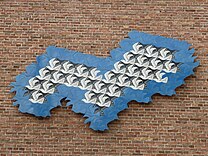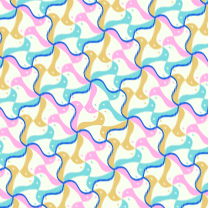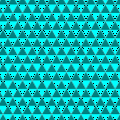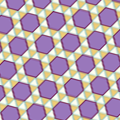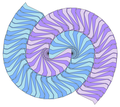Tessellation
A tessellation or tiling is the covering of a
A periodic tiling has a repeating pattern. Some special kinds include
A real physical tessellation is a tiling made of materials such as
History

Tessellations were used by the Sumerians (about 4000 BC) in building wall decorations formed by patterns of clay tiles.[1]
Decorative mosaic tilings made of small squared blocks called tesserae were widely employed in classical antiquity,[2] sometimes displaying geometric patterns.[3][4]
In 1619,
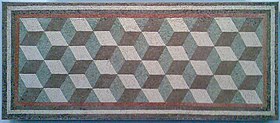
Some two hundred years later in 1891, the Russian crystallographer
Etymology
In Latin, tessella is a small cubical piece of clay, stone, or glass used to make mosaics.[12] The word "tessella" means "small square" (from tessera, square, which in turn is from the Greek word τέσσερα for four). It corresponds to the everyday term tiling, which refers to applications of tessellations, often made of glazed clay.
Overview

Tessellation in two dimensions, also called planar tiling, is a topic in geometry that studies how shapes, known as tiles, can be arranged to fill a plane without any gaps, according to a given set of rules. These rules can be varied. Common ones are that there must be no gaps between tiles, and that no corner of one tile can lie along the edge of another.
Many other types of tessellation are possible under different constraints. For example, there are eight types of semi-regular tessellation, made with more than one kind of regular polygon but still having the same arrangement of polygons at every corner.
More formally, a tessellation or tiling is a
Mathematically, tessellations can be extended to spaces other than the Euclidean plane.
Other methods also exist for describing polygonal tilings. When the tessellation is made of regular polygons, the most common notation is the vertex configuration, which is simply a list of the number of sides of the polygons around a vertex. The square tiling has a vertex configuration of 4.4.4.4, or 44. The tiling of regular hexagons is noted 6.6.6, or 63.[18]
In mathematics
Introduction to tessellations
Mathematicians use some technical terms when discussing tilings. An
The sides of the polygons are not necessarily identical to the edges of the tiles. An edge-to-edge tiling is any polygonal tessellation where adjacent tiles only share one full side, i.e., no tile shares a partial side or more than one side with any other tile. In an edge-to-edge tiling, the sides of the polygons and the edges of the tiles are the same. The familiar "brick wall" tiling is not edge-to-edge because the long side of each rectangular brick is shared with two bordering bricks.[18]
A normal tiling is a tessellation for which every tile is
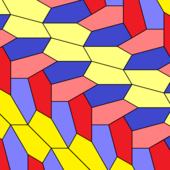
A monohedral tiling is a tessellation in which all tiles are
An isohedral tiling is a special variation of a monohedral tiling in which all tiles belong to the same transitivity class, that is, all tiles are transforms of the same prototile under the symmetry group of the tiling.[23] If a prototile admits a tiling, but no such tiling is isohedral, then the prototile is called anisohedral and forms anisohedral tilings.
A
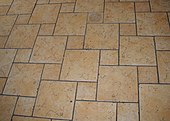
A
Wallpaper groups

Tilings with
Aperiodic tilings

Penrose tilings, which use two different quadrilateral prototiles, are the best known example of tiles that forcibly create non-periodic patterns. They belong to a general class of aperiodic tilings, which use tiles that cannot tessellate periodically. The recursive process of substitution tiling is a method of generating aperiodic tilings. One class that can be generated in this way is the rep-tiles; these tilings have unexpected self-replicating properties.[36] Pinwheel tilings are non-periodic, using a rep-tile construction; the tiles appear in infinitely many orientations.[37] It might be thought that a non-periodic pattern would be entirely without symmetry, but this is not so. Aperiodic tilings, while lacking in translational symmetry, do have symmetries of other types, by infinite repetition of any bounded patch of the tiling and in certain finite groups of rotations or reflections of those patches.[38] A substitution rule, such as can be used to generate Penrose patterns using assemblies of tiles called rhombs, illustrates scaling symmetry.[39] A Fibonacci word can be used to build an aperiodic tiling, and to study quasicrystals, which are structures with aperiodic order.[40]

Wang tiles are squares coloured on each edge, and placed so that abutting edges of adjacent tiles have the same colour; hence they are sometimes called Wang dominoes. A suitable set of Wang dominoes can tile the plane, but only aperiodically. This is known because any Turing machine can be represented as a set of Wang dominoes that tile the plane if, and only if, the Turing machine does not halt. Since the halting problem is undecidable, the problem of deciding whether a Wang domino set can tile the plane is also undecidable.[41][42][43][44][45]
Truchet tiles are square tiles decorated with patterns so they do not have rotational symmetry; in 1704, Sébastien Truchet used a square tile split into two triangles of contrasting colours. These can tile the plane either periodically or randomly.[46][47]
An
Tessellations and colour
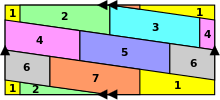
Sometimes the colour of a tile is understood as part of the tiling; at other times arbitrary colours may be applied later. When discussing a tiling that is displayed in colours, to avoid ambiguity, one needs to specify whether the colours are part of the tiling or just part of its illustration. This affects whether tiles with the same shape, but different colours, are considered identical, which in turn affects questions of symmetry. The four colour theorem states that for every tessellation of a normal Euclidean plane, with a set of four available colours, each tile can be coloured in one colour such that no tiles of equal colour meet at a curve of positive length. The colouring guaranteed by the four colour theorem does not generally respect the symmetries of the tessellation. To produce a colouring that does, it is necessary to treat the colours as part of the tessellation. Here, as many as seven colours may be needed, as demonstrated in the image at right.[51]
Tessellations with polygons
Next to the various
Any triangle or quadrilateral (even non-convex) can be used as a prototile to form a monohedral tessellation, often in more than one way. Copies of an arbitrary quadrilateral can form a tessellation with translational symmetry and 2-fold rotational symmetry with centres at the midpoints of all sides. For an asymmetric quadrilateral this tiling belongs to wallpaper group p2. As fundamental domain we have the quadrilateral. Equivalently, we can construct a parallelogram subtended by a minimal set of translation vectors, starting from a rotational centre. We can divide this by one diagonal, and take one half (a triangle) as fundamental domain. Such a triangle has the same area as the quadrilateral and can be constructed from it by cutting and pasting.[52]
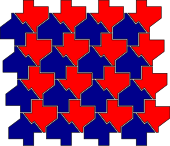
If only one shape of tile is allowed, tilings exist with convex N-gons for N equal to 3, 4, 5, and 6. For N = 5, see Pentagonal tiling, for N = 6, see Hexagonal tiling, for N = 7, see Heptagonal tiling and for N = 8, see octagonal tiling.
With non-convex polygons, there are far fewer limitations in the number of sides, even if only one shape is allowed.
Voronoi tilings
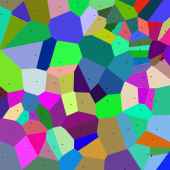
Voronoi or Dirichlet tilings are tessellations where each tile is defined as the set of points closest to one of the points in a discrete set of defining points. (Think of geographical regions where each region is defined as all the points closest to a given city or post office.)[53][54] The Voronoi cell for each defining point is a convex polygon. The Delaunay triangulation is a tessellation that is the dual graph of a Voronoi tessellation. Delaunay triangulations are useful in numerical simulation, in part because among all possible triangulations of the defining points, Delaunay triangulations maximize the minimum of the angles formed by the edges.[55] Voronoi tilings with randomly placed points can be used to construct random tilings of the plane.[56]
Tessellations in higher dimensions

Tessellation can be extended to three dimensions. Certain

Tessellations in three or more dimensions are called honeycombs. In three dimensions there is just one regular honeycomb, which has eight cubes at each polyhedron vertex. Similarly, in three dimensions there is just one quasiregular[c] honeycomb, which has eight tetrahedra and six octahedra at each polyhedron vertex. However, there are many possible semiregular honeycombs in three dimensions.[61] Uniform honeycombs can be constructed using the Wythoff construction.[62]
The Schmitt-Conway biprism is a convex polyhedron with the property of tiling space only aperiodically.[63]
A
Tessellations in non-Euclidean geometries

It is possible to tessellate in
A
In art
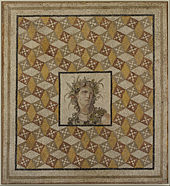
In architecture, tessellations have been used to create decorative motifs since ancient times.
Tessellations frequently appeared in the graphic art of M. C. Escher; he was inspired by the Moorish use of symmetry in places such as the Alhambra when he visited Spain in 1936.[70] Escher made four "Circle Limit" drawings of tilings that use hyperbolic geometry.[71][72] For his woodcut "Circle Limit IV" (1960), Escher prepared a pencil and ink study showing the required geometry.[73] Escher explained that "No single component of all the series, which from infinitely far away rise like rockets perpendicularly from the limit and are at last lost in it, ever reaches the boundary line."[74]

Tessellated designs often appear on textiles, whether woven, stitched in, or printed. Tessellation patterns have been used to design interlocking motifs of patch shapes in quilts.[75][76]
Tessellations are also a main genre in origami (paper folding), where pleats are used to connect molecules, such as twist folds, together in a repeating fashion.[77]
In manufacturing
Tessellation is used in
Tessellation is apparent in the
In nature
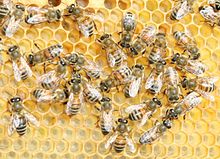
The honeycomb is a well-known example of tessellation in nature with its hexagonal cells.[82]
In botany, the term "tessellate" describes a checkered pattern, for example on a flower petal, tree bark, or fruit. Flowers including the fritillary,[83] and some species of Colchicum, are characteristically tessellate.[84]
Many

Other natural patterns occur in foams; these are packed according to Plateau's laws, which require minimal surfaces. Such foams present a problem in how to pack cells as tightly as possible: in 1887, Lord Kelvin proposed a packing using only one solid, the bitruncated cubic honeycomb with very slightly curved faces. In 1993, Denis Weaire and Robert Phelan proposed the Weaire–Phelan structure, which uses less surface area to separate cells of equal volume than Kelvin's foam.[90]
In puzzles and recreational mathematics
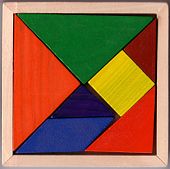
Tessellations have given rise to many types of
Examples
-
regular tilingsof the plane
-
semiregular tilingof the plane
-
pentagon tilings
-
All tiling elements are identical pseudo‑triangles by disregarding their colors and ornaments
-
Theenneagons
-
Alternated octagonal or tritetragonal tiling is a uniform tiling of the hyperbolic plane
-
Topological square tiling, isohedrally distorted into I shapes
See also
Explanatory footnotes
- ^ The mathematical term for identical shapes is "congruent" – in mathematics, "identical" means they are the same tile.
- closed disk, which means bizarre shapes with holes, dangling line segments, or infinite areas are excluded.[18]
- ^ In this context, quasiregular means that the cells are regular (solids), and the vertex figures are semiregular.
References
- ^ ISBN 978-1-4027-5796-9.
- ^ Dunbabin, Katherine M. D. (2006). Mosaics of the Greek and Roman world. Cambridge University Press. p. 280.
- ^ "The Brantingham Geometric Mosaics". Hull City Council. 2008. Retrieved 26 May 2015.
- ^ ISBN 978-0-906-21263-9.
- ^ Kepler, Johannes (1619). Harmonices Mundi [Harmony of the Worlds].
- ^ a b c Gullberg 1997, p. 395.
- ^ Stewart 2001, p. 13.
- ^ Djidjev, Hristo; Potkonjak, Miodrag (2012). "Dynamic Coverage Problems in Sensor Networks" (PDF). Los Alamos National Laboratory. p. 2. Retrieved 6 April 2013.
- Fyodorov, Y.(1891). "Simmetrija na ploskosti [Symmetry in the plane]". Zapiski Imperatorskogo Sant-Petersburgskogo Mineralogicheskogo Obshchestva [Proceedings of the Imperial St. Petersburg Mineralogical Society]. 2 (in Russian). 28: 245–291.
- ^ Shubnikov, Alekseĭ Vasilʹevich; Belov, Nikolaĭ Vasilʹevich (1964). Colored Symmetry. Macmillan.
- ^ Heesch, H.; Kienzle, O. (1963). Flächenschluss: System der Formen lückenlos aneinanderschliessender Flächteile (in German). Springer.
- ^ "Tessellate". Merriam-Webster Online. Retrieved 26 May 2015.
- ^ Conway, R.; Burgiel, H.; Goodman-Strauss, G. (2008). The Symmetries of Things. Peters.
- ^ Coxeter 1973.
- ^ Cundy and Rollett (1961). Mathematical Models (2nd ed.). Oxford. pp. 61–62.
- ^ Escher 1974, pp. 11–12, 15–16.
- ^ "Basilica di San Marco". Section: Tessellated floor. Basilica di San Marco. Retrieved 26 April 2013.
- ^ a b c d e f Grünbaum & Shephard 1987, p. 59.
- JSTOR 2689617.
- ISBN 978-0-486-61480-9.
- ^ Weisstein, Eric W. "Tessellation". MathWorld.
- ISBN 978-3-540-28849-7.
- ^ ISBN 978-1-85573-492-0.
- ^ Dutch, Steven (29 July 1999). "Some Special Radial and Spiral Tilings". University of Wisconsin. Archived from the original on 4 April 2013. Retrieved 6 April 2013.
- .
- ^ Weisstein, Eric W. "Regular Tessellations". MathWorld.
- ^ Stewart 2001, p. 75.
- ^ NRICH (Millennium Maths Project) (1997–2012). "Schläfli Tessellations". University of Cambridge. Retrieved 26 April 2013.
- ISBN 978-0-14-011813-1.
- S2CID 123579388.
- ISBN 978-3-540-96675-3.
- ^ Grünbaum, Branko (June–July 2006). "What symmetry groups are present in the Alhambra?" (PDF). Notices of the American Mathematical Society. 53 (6): 670–673.
- S2CID 10374218.
- ^ Weisstein, Eric W. "Frieze Group". MathWorld.
- CiteSeerX 10.1.1.30.8536– via CiteSeerX.
- ^ Gardner 1989, pp. 1–18.
- JSTOR 2118575.
- ^ Austin, David. "Penrose Tiles Talk Across Miles". American Mathematical Society. Retrieved 29 May 2015.
- ^ Harriss, E. O. "Aperiodic Tiling" (PDF). University of London and EPSRC. Archived from the original (PDF) on 29 August 2017. Retrieved 29 May 2015.
- PMID 10034529.
- .
- ^ Wang, Hao (November 1965). "Games, logic and computers". Scientific American. pp. 98–106.
- .
- S2CID 14259496.
- MR 1417576.
- .
- S2CID 192944820.
- ^ Conover, Emily (24 March 2023). "Mathematicians have finally discovered an elusive 'einstein' tile". Science News. Retrieved 25 March 2023. with image of the pattern
- ^ Smith, David; Myers, Joseph Samuel; Kaplan, Craig S.; Goodman-Strauss, Chaim (March 2023). "An aperiodic monotile". arXiv:2303.10798
- ^ Roberts, Soibhan, Elusive 'Einstein' Solves a Longstanding Mathematical Problem, the New York Times, March 28, 2023, with image of the pattern
- ^ "Four-colour problem", Encyclopedia of Mathematics, EMS Press, 2001 [1994]
- ^ Jones, Owen (1910) [1856]. The Grammar of Ornament (folio ed.). Bernard Quaritch.
- S2CID 4613674.
- ISBN 978-0-471-98635-5.
- ISBN 978-2-86601-692-0.
- ISBN 978-1-4612-2652-9.
- ^ Grünbaum, Branko (1994). "Uniform tilings of 3-space". Geombinatorics. 4 (2): 49–56.
- MR 0598811..
- ISBN 978-1-55297-814-6.
- ^ Kirkaldy, J. F. (1968). Minerals and Rocks in Colour (2nd ed.). Blandford. pp. 138–139.
- ISBN 978-0-471-01003-6.
- ^ Weisstein, Eric W. "Wythoff construction". MathWorld.
- ISBN 978-0-521-57541-6.
- S2CID 121698536.
- ].
- ^ Zadnik, Gašper. "Tiling the Hyperbolic Plane with Regular Polygons". Wolfram. Retrieved 27 May 2015.
- ISBN 978-0-486-40919-1.
- ^ "Mathematics in Art and Architecture". National University of Singapore. Retrieved 17 May 2015.
- ISBN 978-1-85418-605-8.
- ^ Escher 1974, pp. 5, 17.
- ^ Gersten, S. M. "Introduction to Hyperbolic and Automatic Groups" (PDF). University of Utah. Retrieved 27 May 2015.
Figure 1 is part of a tiling of the Euclidean plane, which we imagine as continued in all directions, and Figure 2 [Circle Limit IV] is a beautiful tesselation of the Poincaré unit disc model of the hyperbolic plane by white tiles representing angels and black tiles representing devils. An important feature of the second is that all white tiles are mutually congruent as are all black tiles; of course this is not true for the Euclidean metric, but holds for the Poincaré metric
- ^ Leys, Jos (2015). "Hyperbolic Escher". Retrieved 27 May 2015.
- ^ Escher 1974, pp. 142–143.
- ^ Escher 1974, p. 16.
- ISBN 978-0-7153-1941-3.
- ISBN 978-0-8092-2866-9.
- ISBN 978-1-568-81451-3.
- ^ "Reducing yield losses: using less metal to make the same thing". UIT Cambridge. Archived from the original on 29 May 2015. Retrieved 29 May 2015.
- .
- .
- PMID 26437880.
- S2CID 138195687. Retrieved 7 November 2014.
- ISBN 978-0-19-920687-2.
- ^ Purdy, Kathy (2007). "Colchicums: autumn's best-kept secret". American Gardener (September/October): 18–22.
- ].
- S2CID 119949515.
- ^ Gilbert, E. N. (1967). "Random plane networks and needle-shaped crystals". In Noble, B. (ed.). Applications of Undergraduate Mathematics in Engineering. New York: Macmillan.
- .
- OCLC 12650092.
- ISBN 978-0-199-60486-9.
- ^ McAdam, Daniel. "History of Jigsaw Puzzles". American Jigsaw Puzzle Society. Archived from the original on 11 February 2014. Retrieved 28 May 2015.
- ISBN 978-1-4351-0156-2.
- ISBN 978-0-691-02444-8.
- ISBN 978-0-88385-501-0.
- ISBN 978-0-521-81192-7.
- ^ Gardner, Martin (May 1963). "On 'Rep-tiles,' Polygons that can make larger and smaller copies of themselves". Scientific American. Vol. 208, no. May. pp. 154–164.
- ISBN 978-0-88385-551-5.
- ^ Suri, Mani (12 October 2015). "The Importance of Recreational Math". New York Times.
- JSTOR 2689644.
- ^ Tutte, W. T. "Squaring the Square". Squaring.net. Retrieved 29 May 2015.
- ^ Gardner, Martin; Tutte, William T. (November 1958). "Mathematical Games". Scientific American.
- S2CID 26663945. Archived from the original(PDF) on 20 June 2006.
Sources
- ISBN 978-0-486-61480-9.
- ISBN 978-0-451-79961-6.
- ISBN 978-0-88385-521-8.
- ISBN 978-0-7167-1193-3.
- ISBN 978-0-393-04002-9.
- ISBN 978-0-297-60723-6.
External links
- Tegula (open-source software for exploring two-dimensional tilings of the plane, sphere and hyperbolic plane; includes databases containing millions of tilings)
- Wolfram MathWorld: Tessellation (good bibliography, drawings of regular, semiregular and demiregular tessellations)
- Dirk Frettlöh and Edmund Harriss. "Tilings Encyclopedia" (extensive information on substitution tilings, including drawings, people, and references)
- Tessellations.org (how-to guides, Escher tessellation gallery, galleries of tessellations by other artists, lesson plans, history)
- Eppstein, David. "The Geometry Junkyard: Hyperbolic Tiling". (list of web resources including articles and galleries)

